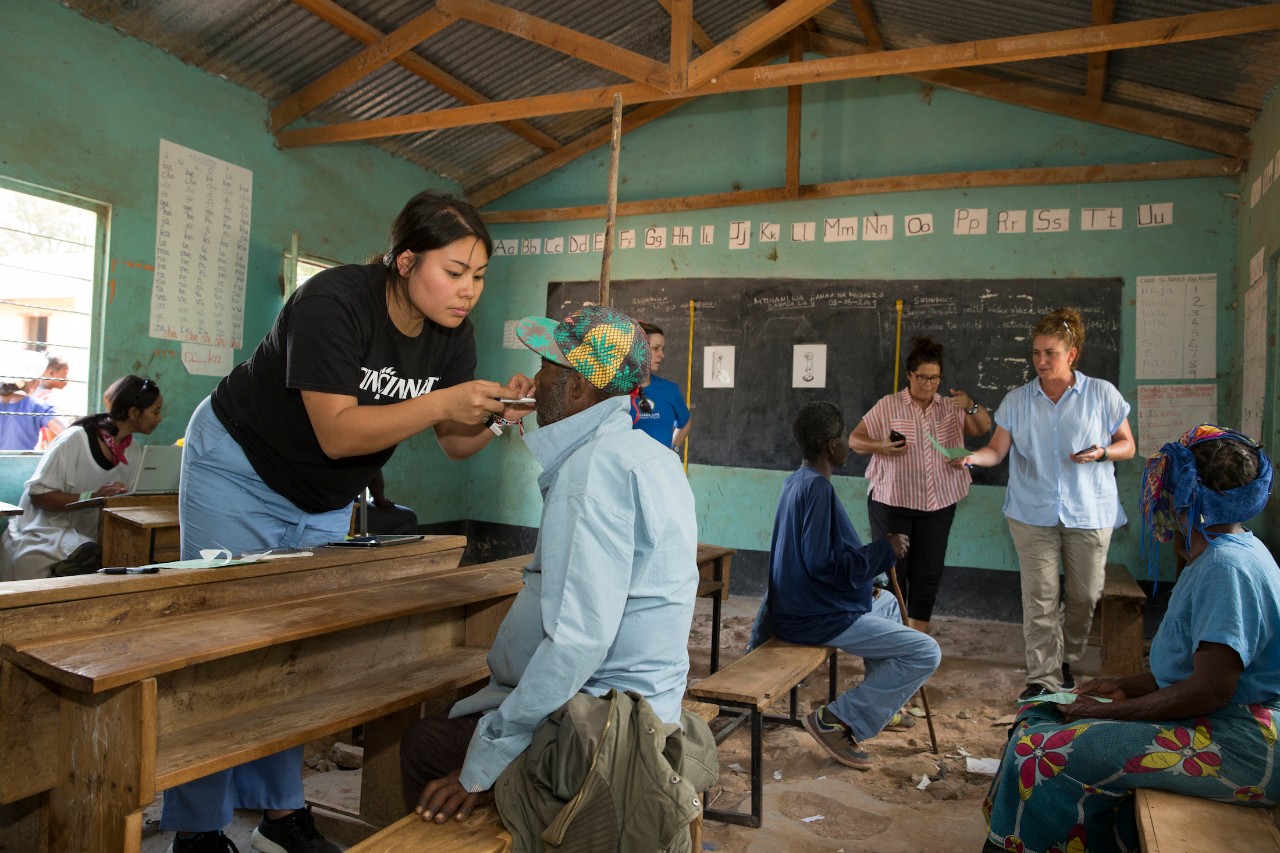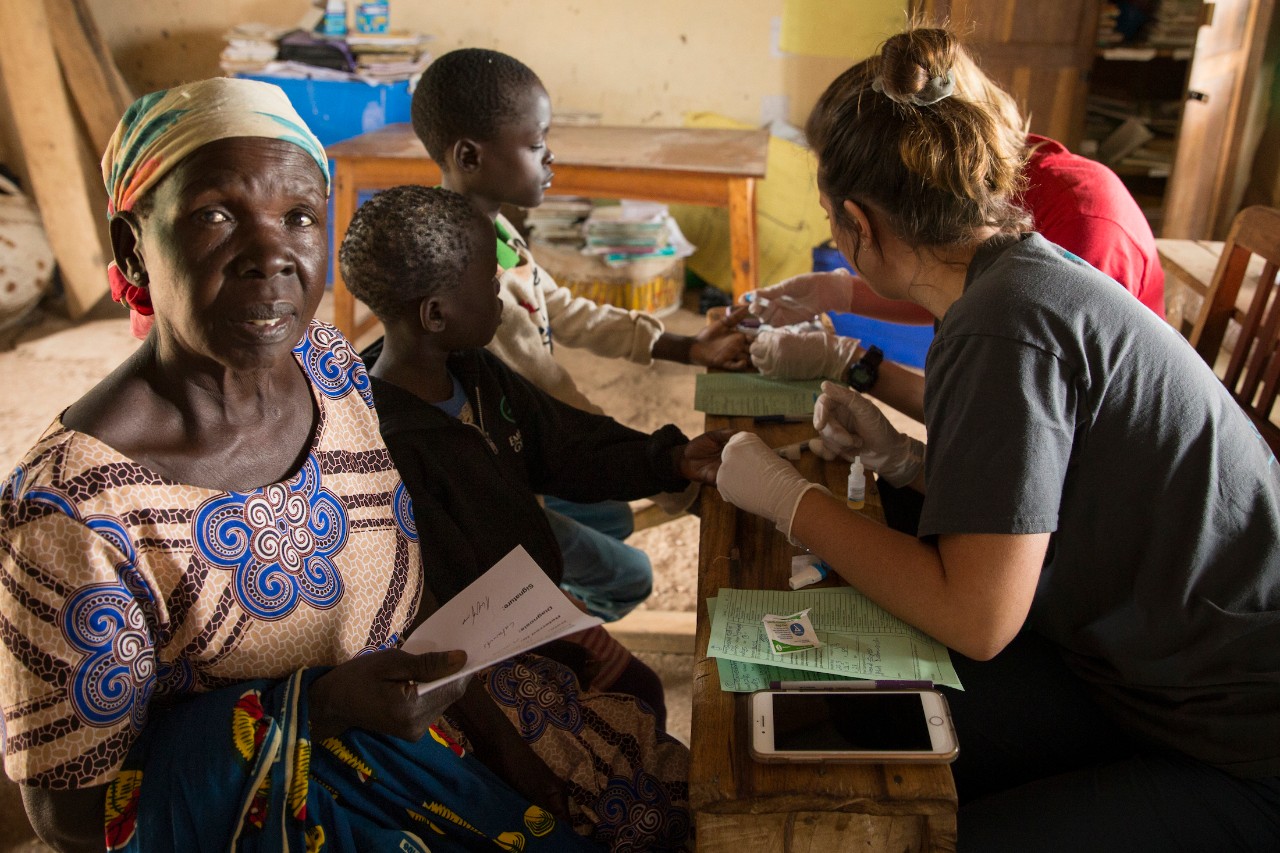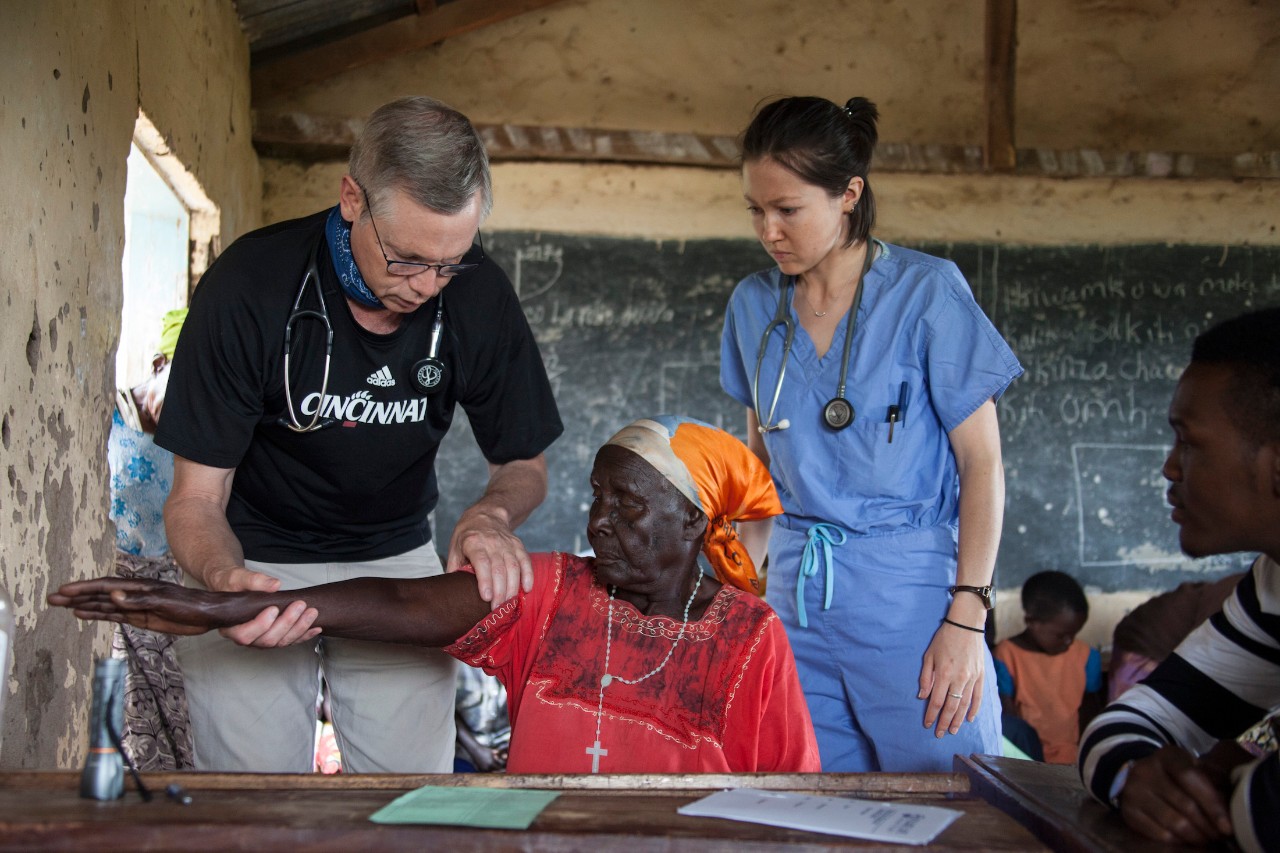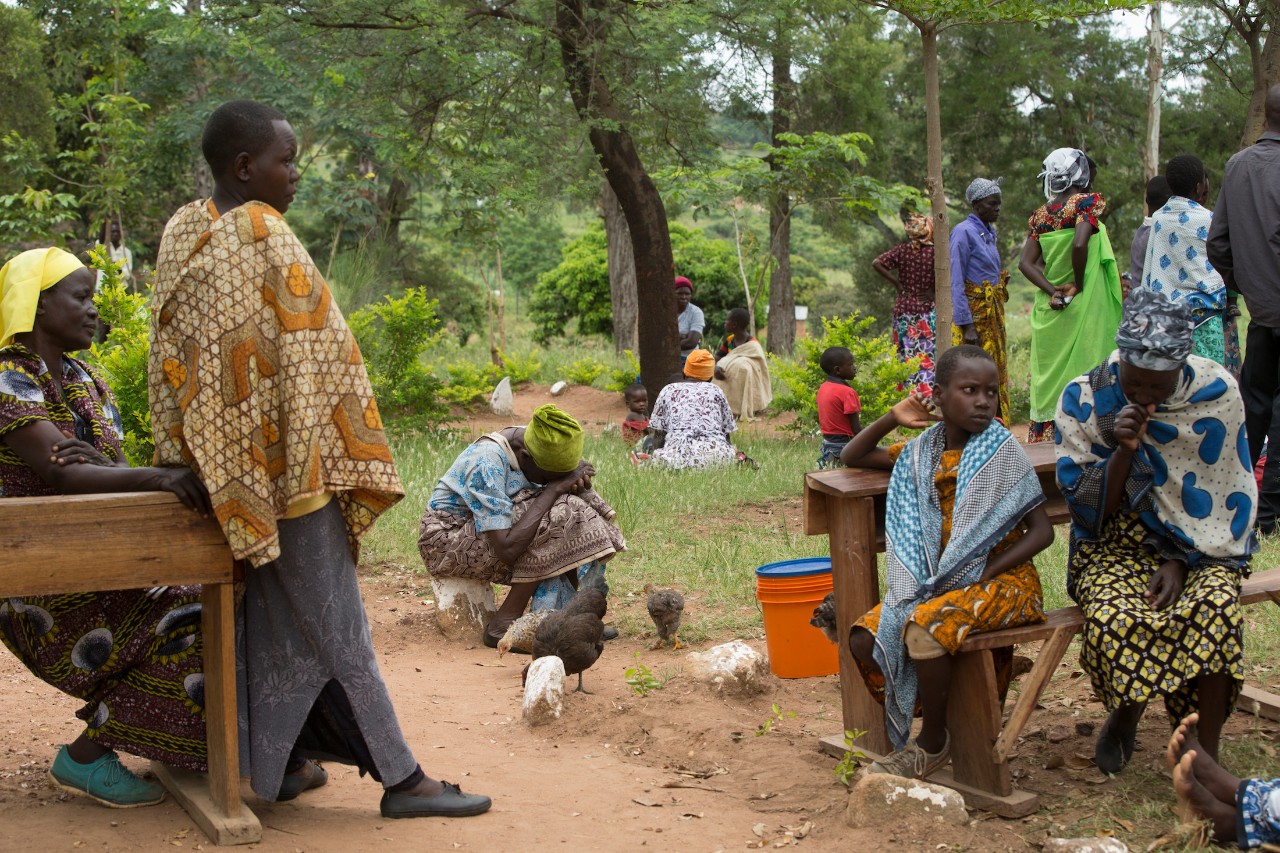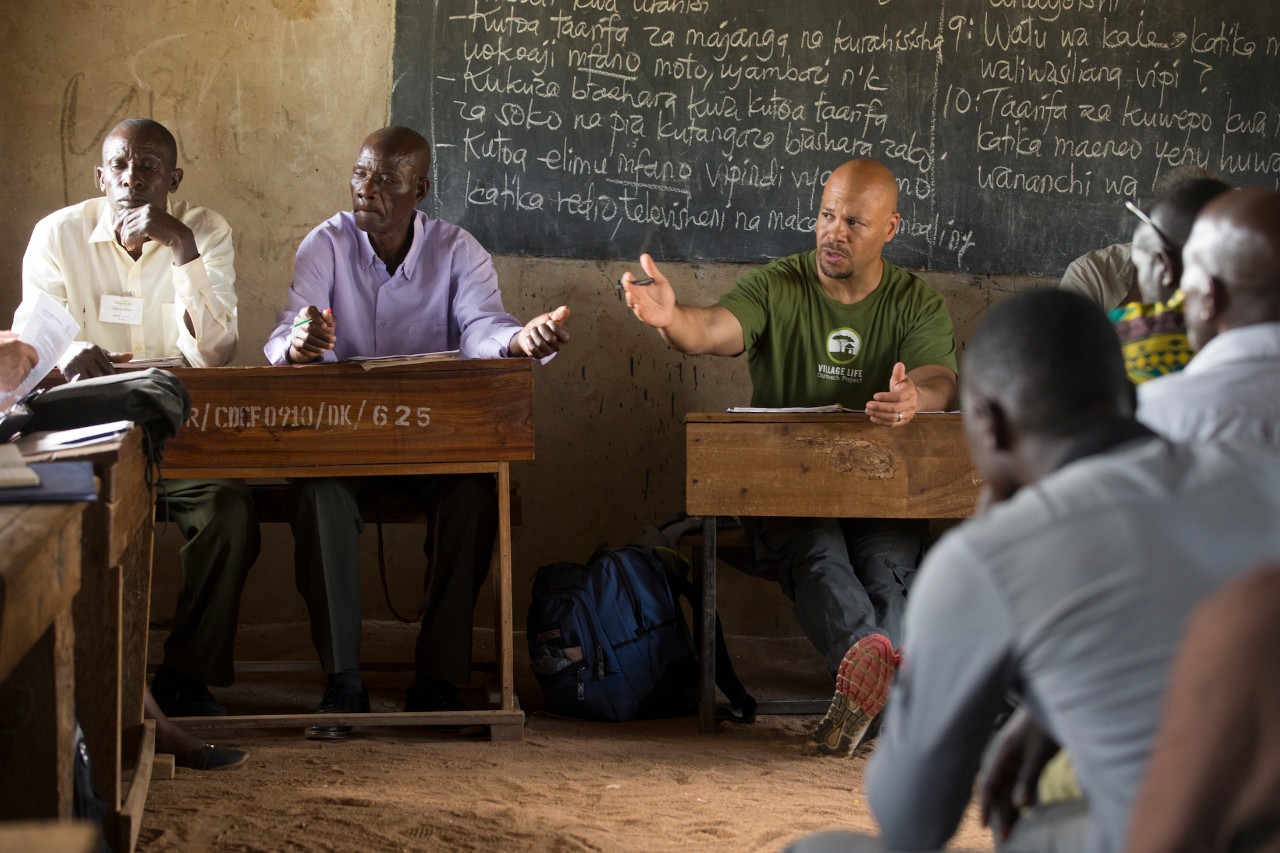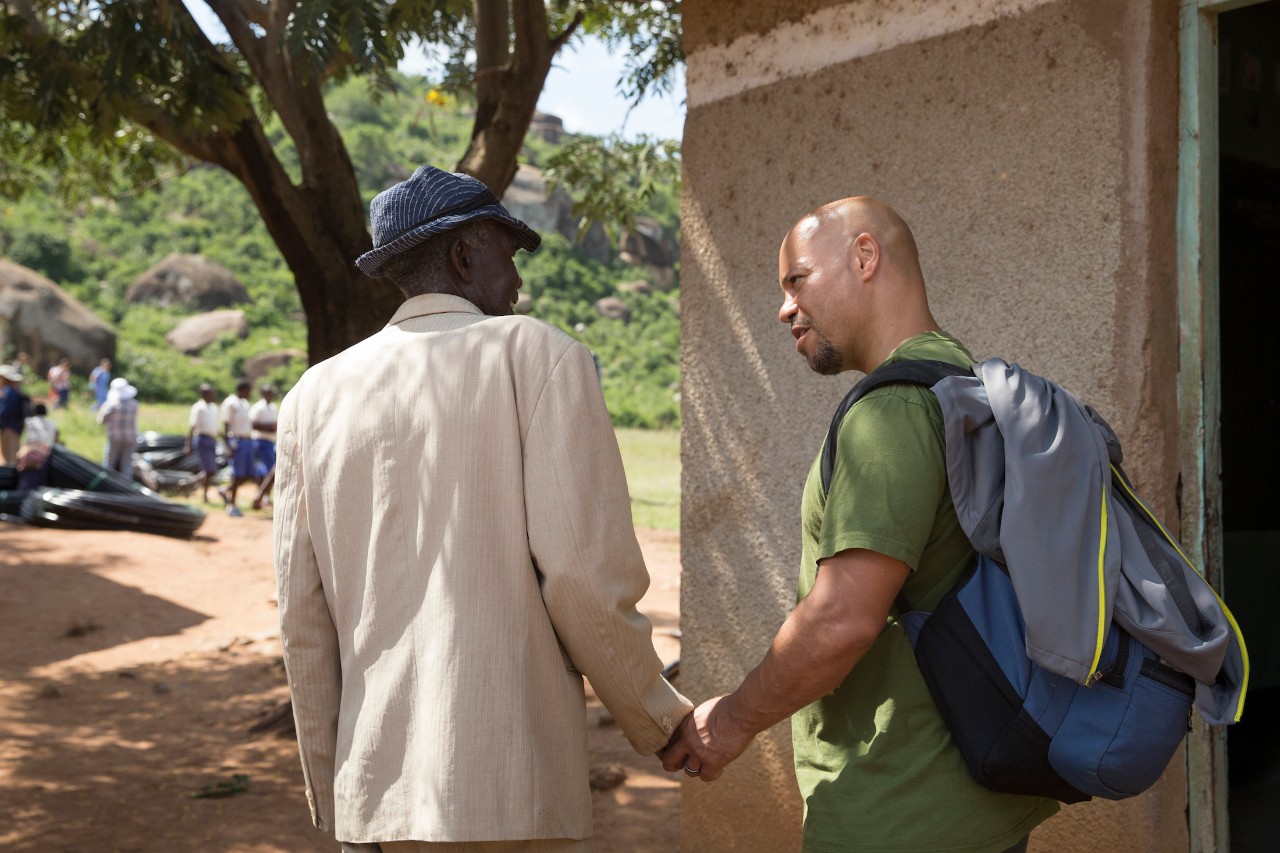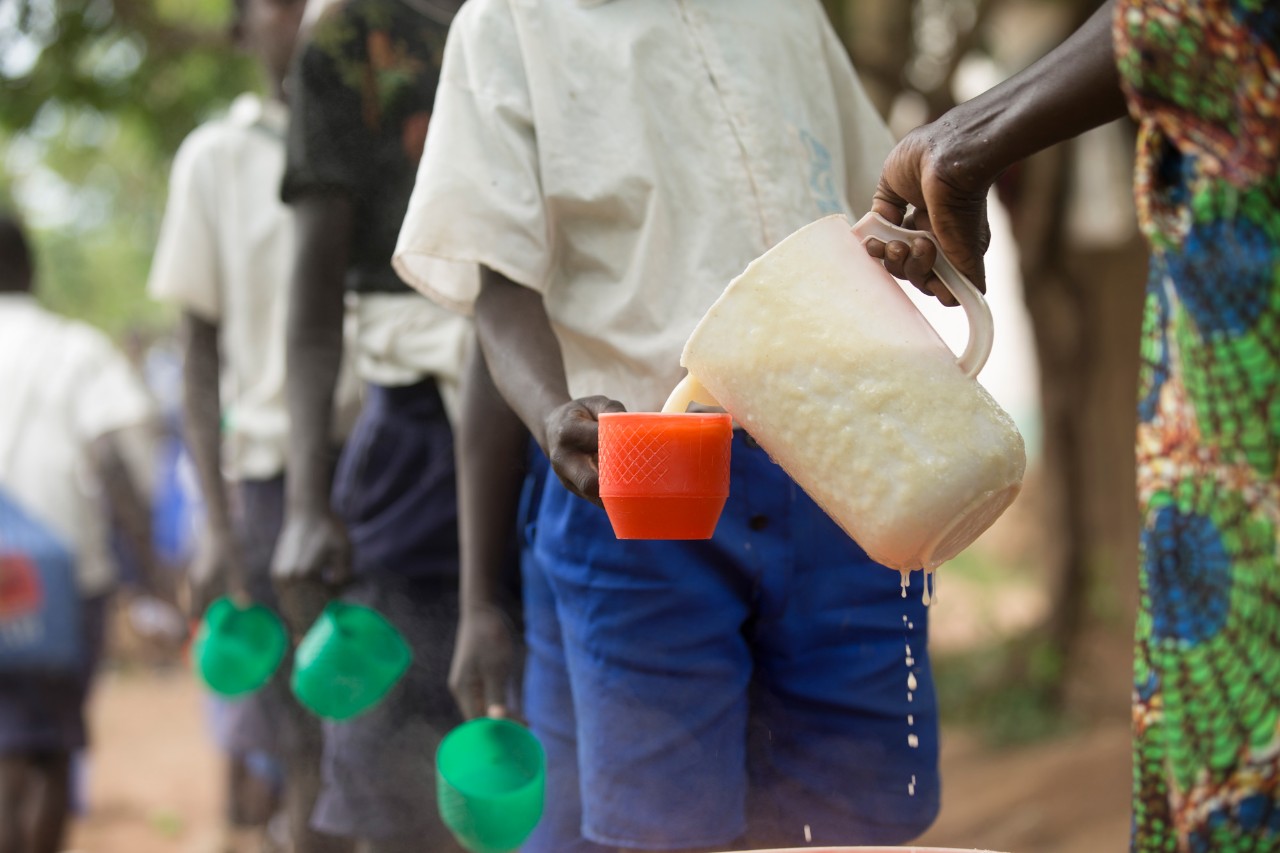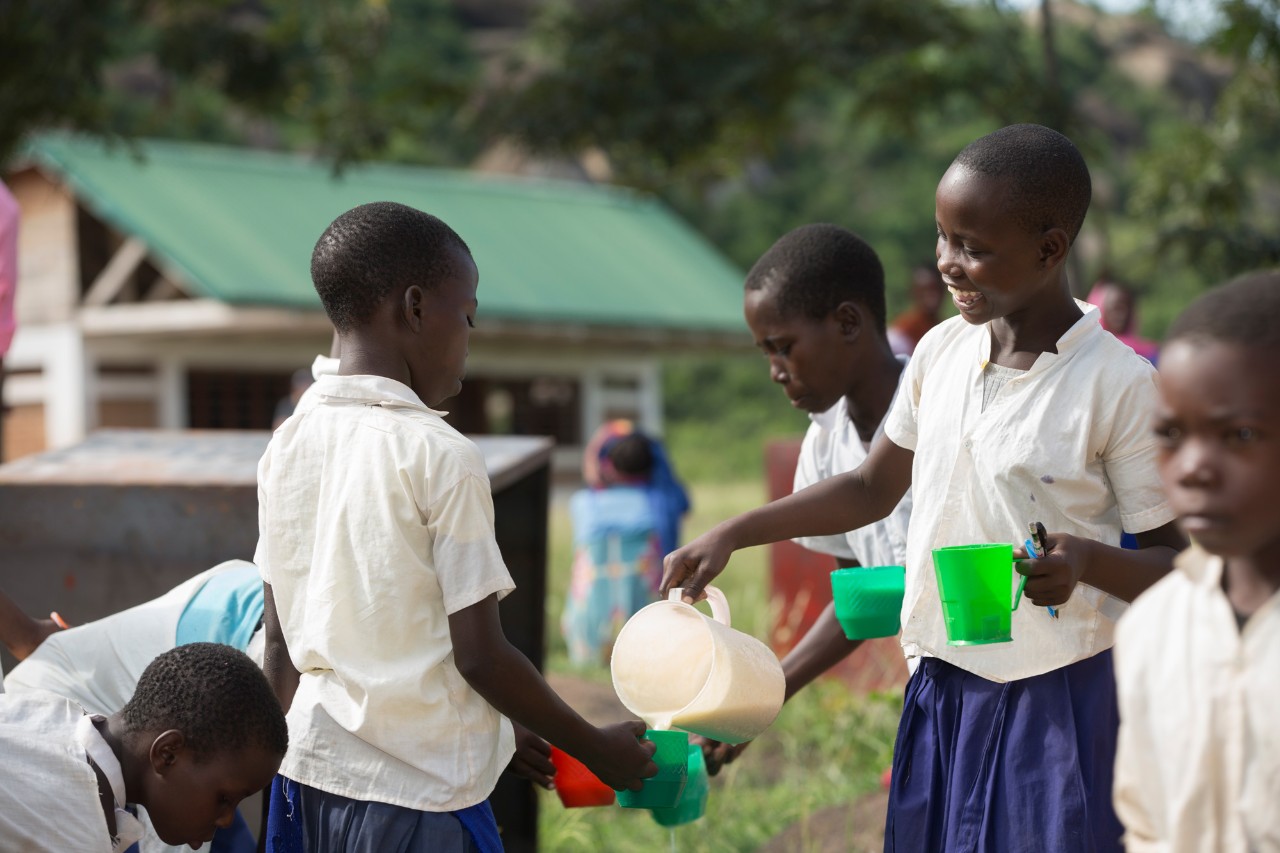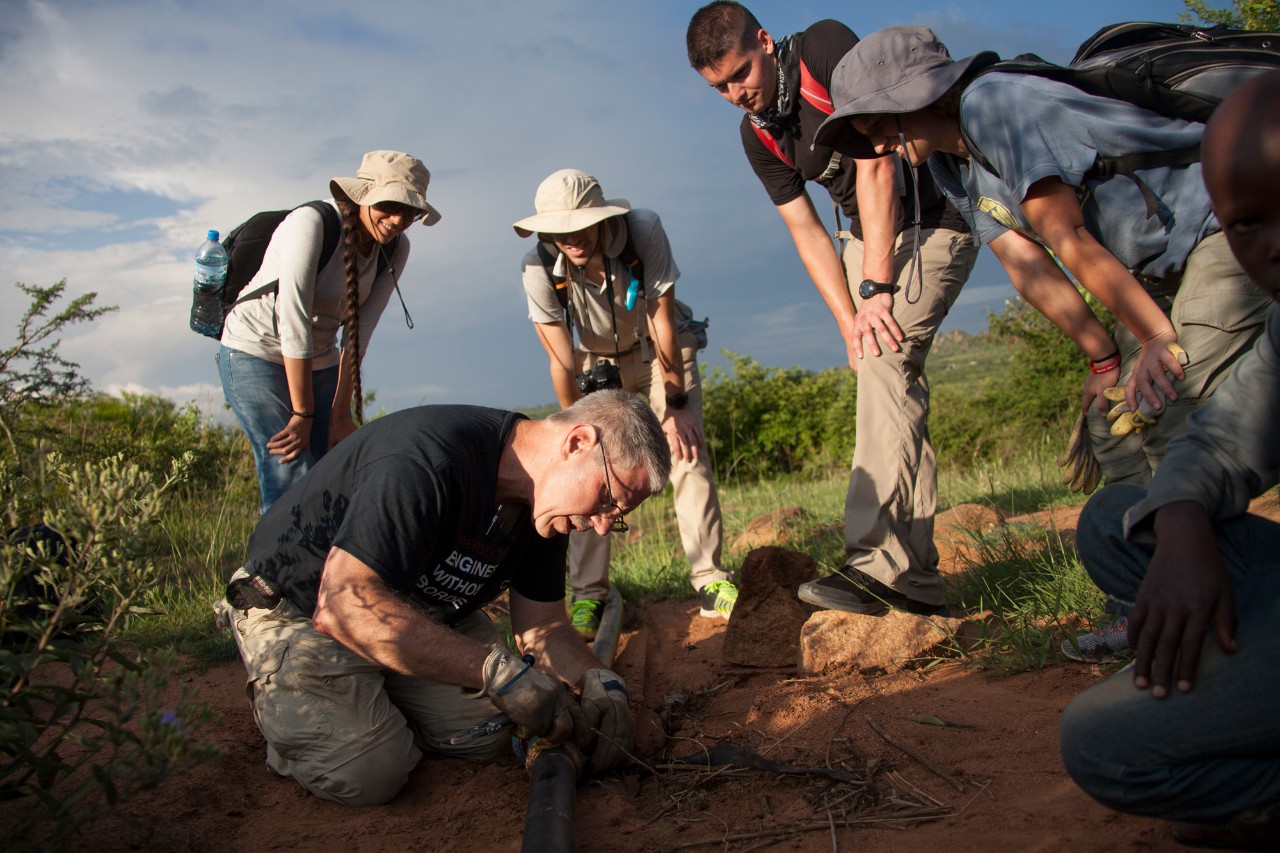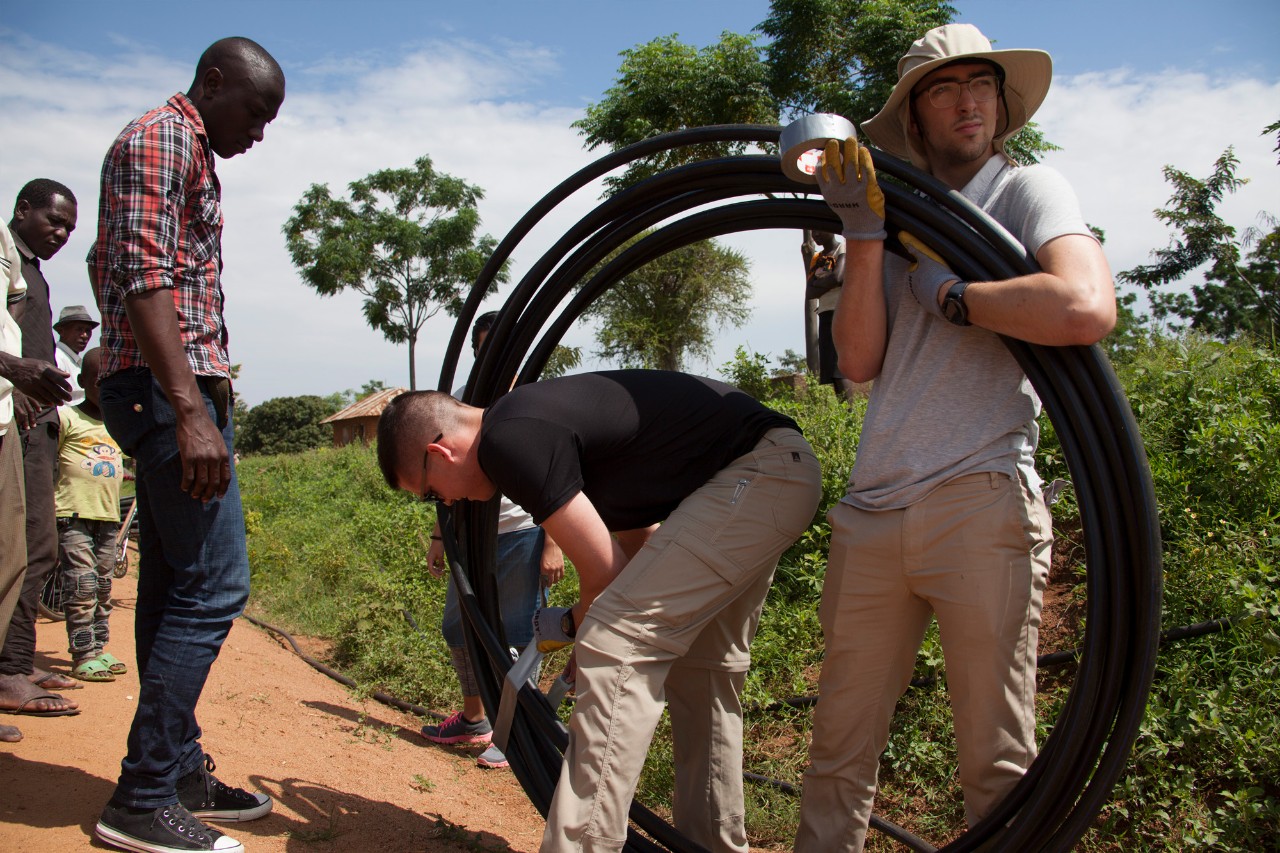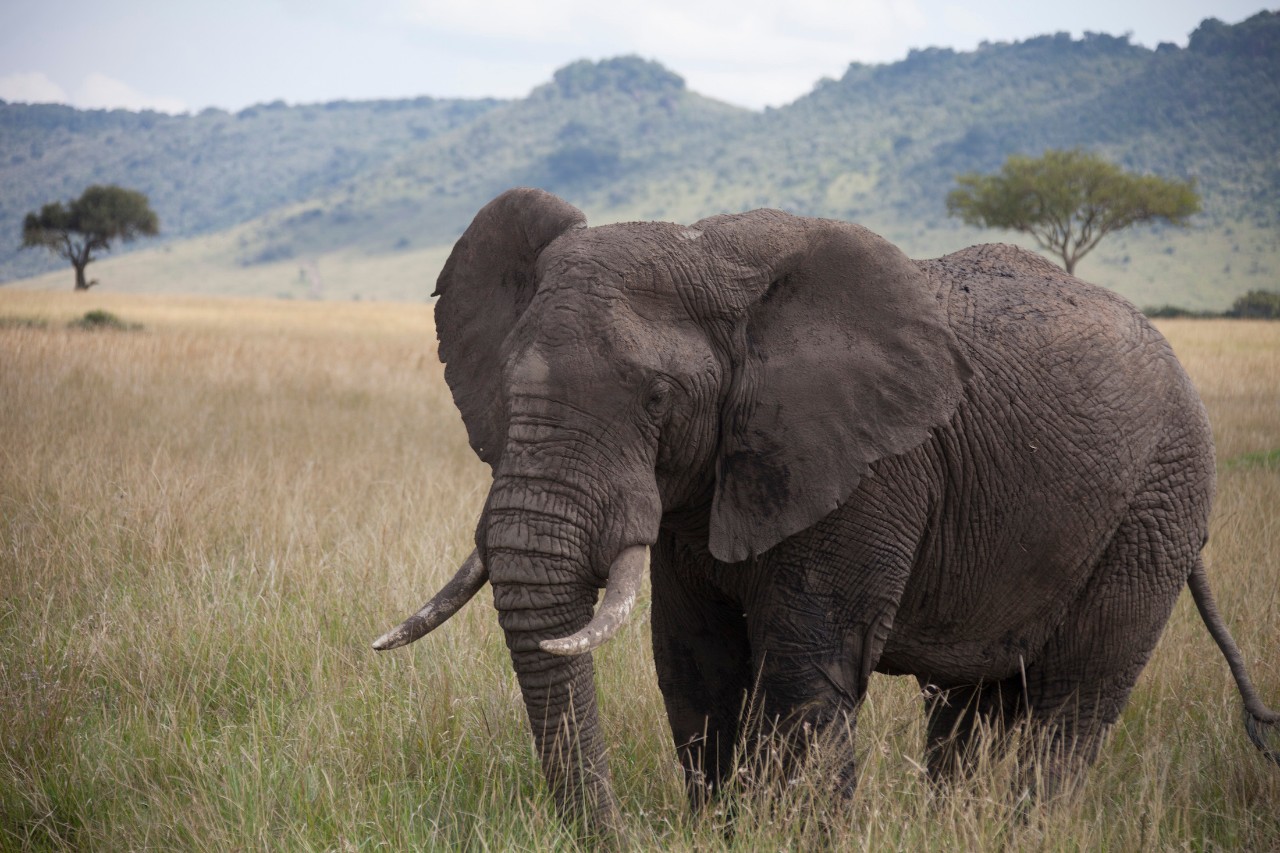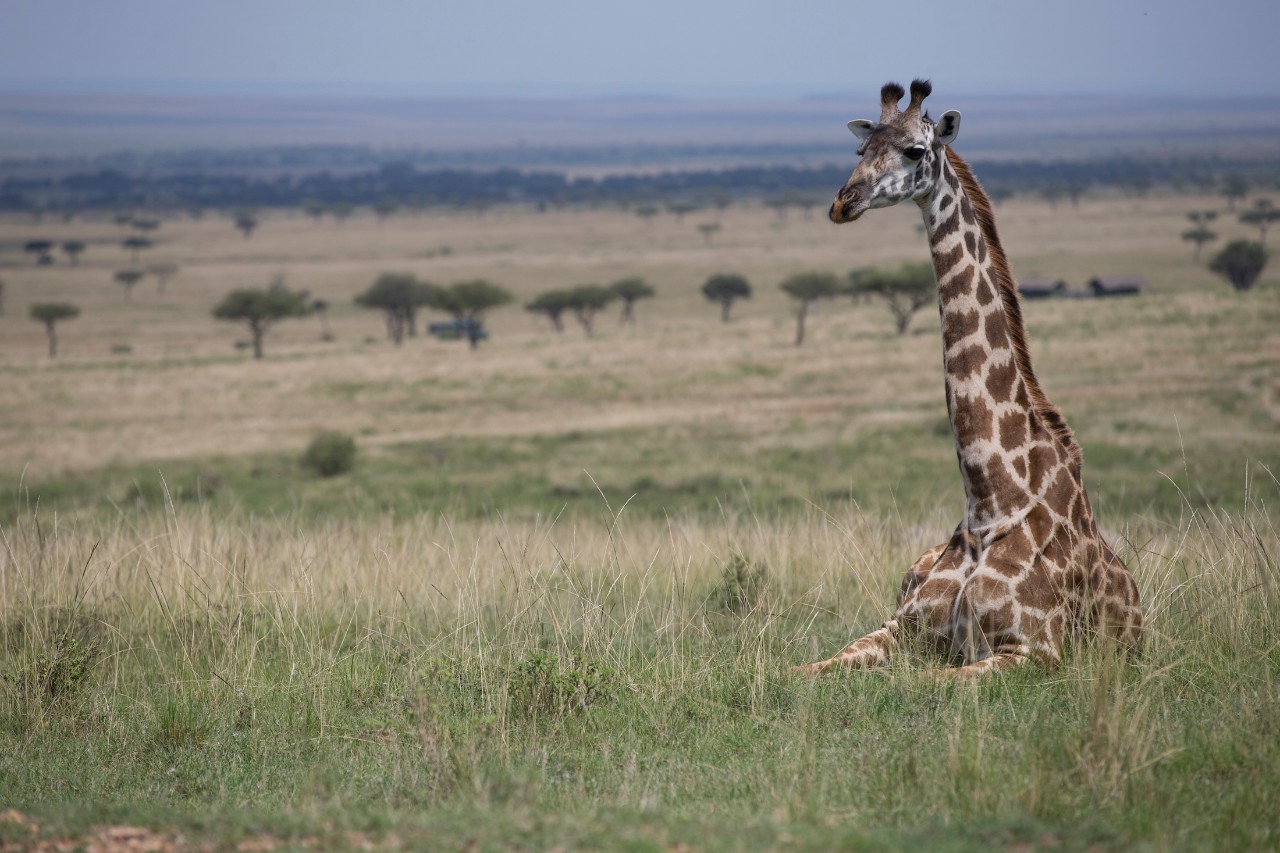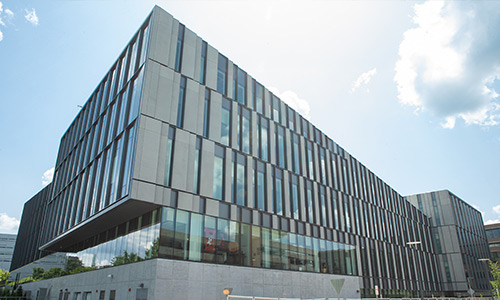UC Magazine joined a two-week trip to Tanzania in June 2019 with volunteers including University of Cincinnati students, faculty and staff. The nonprofit Village Life Outreach Project has sent hundreds of volunteers from UC to three remote villages in East Africa since it started 15 years ago, an effort that has deeply impacted countless lives on both sides of the world.
By John Bach
Photography By Lisa Ventre
warm wash of natural light spills
through an open door in the one-room building at the Nyambogo primary school — just enough light, it seems, to practice medicine.
A grandmother and her two grandchildren — 10-year-old Sombe and 6-year-old Susana — are crowded onto a two-seater handmade wooden school bench in the corner as they wait for the children’s malaria test results. Sombe looks down at the prick on his finger from the blood test as he digs his foot into a hole in the uneven and pocked concrete floor. His sister’s scalp is bleached white in places, and she’s missing patches of hair from ringworm, a fungal infection commonly seen here due in part to the shortage of water for washing.
At the center of the room, Diandra Fortune, a first-year medical student from the University of Cincinnati, and Brianna Tomasi, a 2017 UC nursing alumna and a pediatric nurse at Cincinnati Children’s Hospital Medical Center, call families forward to be tested for malaria. As it turns out, 31 of 42 tests are positive today — three out of every four, a high percentage, even for this part of Africa.
After a 20-minute wait, the UC team calls Sombe and Susana’s family up for results by way of a Swahili translator. Their grandma, Conslatta Onyango, looks away through the school’s back window, where lush green mountains roll above the thatched roof huts that dot the idyllic landscape. She barely reacts when she hears the kids have malaria. She’s heard it before, and she’ll likely hear it again, even as soon as the next day.
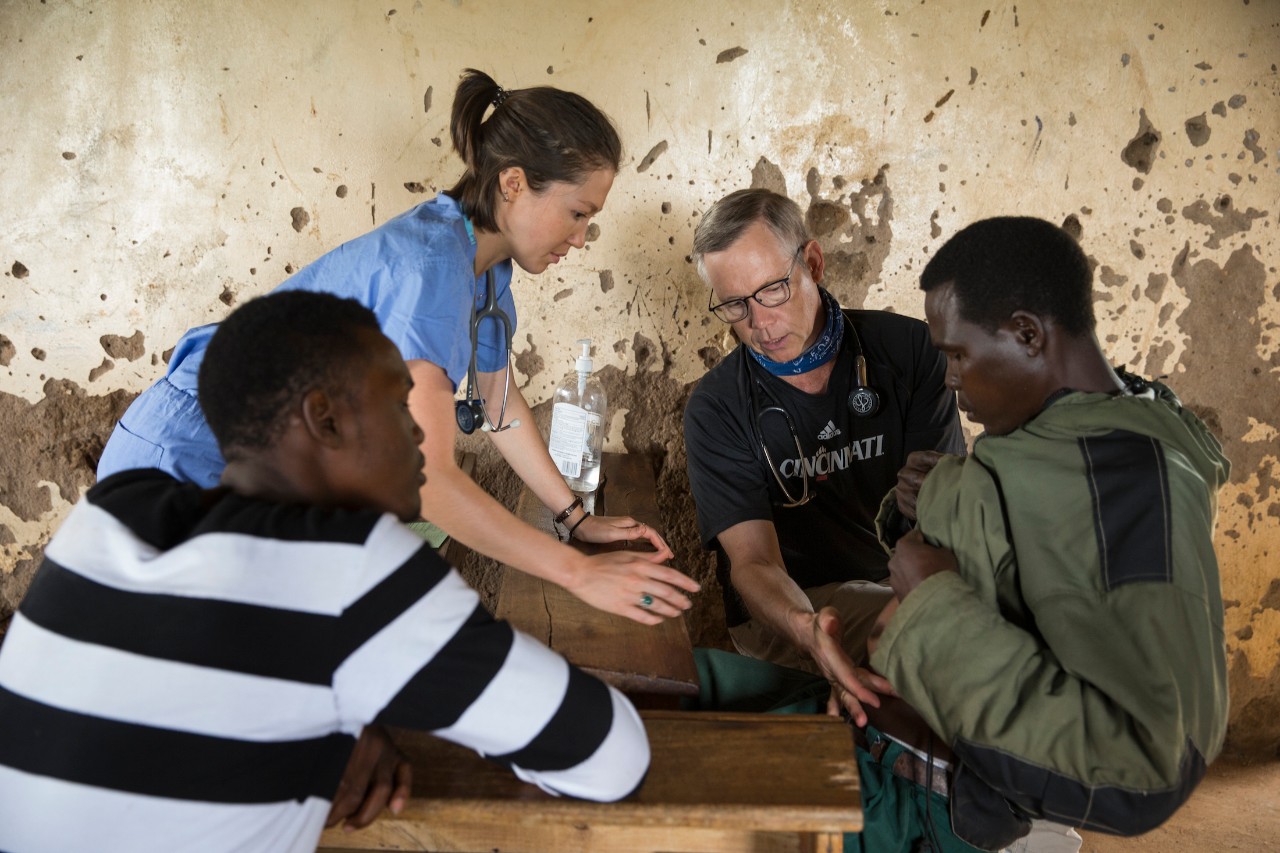
The family walked nearly two miles with three sick kids to get here, and they’ll need to trek back to the school the next day so the youngest grandchild, a 4-year-old boy who’s also running a fever, can be seen by the UC team. Though the doctors, nurses and students saw 62 patients in one afternoon, he was among the many sitting outside who weren’t able to be seen. It’s a cruel but common occurrence at these pop-up field clinics. The demand for care is greater than what the team can provide as the hours, the medicine or both simply run out. And for the people here who survive on about $1 a day, no other options are as accessible or affordable.
Based out of the 1819 Innovation Hub at the University of Cincinnati, Village Life Outreach Project is celebrating its 15th year as a nonprofit that leads a few of these trips, or “brigades” as they call them, every year. Each normally includes a couple dozen UC faculty and students as well as UC Health employees, who work in three remote villages in northern Tanzania. By building partnerships with the locals in the villages of Nyambogo, Burere and Roche, Village Life has been able to treat close to 20,000 people in mobile field clinics, introduce clean drinking water, sustain a crucial food program in the schools and build new facilities, including a 24-hour health care center.
The experience for those who endure 20 hours in an airplane and a 12-hour van ride over rough terrain to get here is often powerful and at times paradigm shifting — so much so, that trip organizers encourage members to keep a journal as a healthy way to deal with all the realities and the flood of emotions.
“One of the first cases we saw here was a really sick 2-year-old with malaria,” recent UC nursing grad Tomasi shares between patients. She’s on her second trip to Tanzania after coming as a student in 2015. “He was in respiratory distress and had a fever. I pricked his finger, and he didn’t even respond to me. At home [at Children’s Hospital] that would be such a huge deal on the floor. It would be all hands on deck, and I’d be calling all the teams to get the malaria under control. It’s just such a different environment.”
Stewart Wright, a doctor, UC professor of emergency medicine and associate chief medical officer at UC Health, is on his third trip to Tanzania in just eight months. In March, the health team saw 400 patients in just three days. Wright points out that people in this part of the world deal with the deadliest type of malaria, a strain known as Falciparum malaria.
“If left untreated, there is a 50% mortality rate for the type of malaria in this part of sub-Saharan Africa,” says Wright, who is also vice chair of Village Life. “It is a fascinating disease but a terrible illness.” With the right medication, however, the parasites that “set up shop inside the liver” can be killed off in a matter of days, he says.
Spread by mosquitoes, the telltale signs include a high fever, headache, diarrhea, nausea and a cough — all symptoms physician Art Pancioli saw nonstop while treating patients during the trip. At home, Pancioli is an emergency medicine physician and the chair of the department of emergency medicine at the UC College of Medicine.
Standing outside a field clinic in Burere after a full day of seeing sick patients, Pancioli’s eyes well up with tears when talking about the impact of practicing medicine in Tanzania.
“Ultimately, it is about heart,” he says. “The heart of the people who do or have done this is forever changed invariably for the better. You can’t do this kind of medicine and not forever want to do more. The most joyful man I saw today had been attacked by robbers and hacked in the knee. The simple provision of a cane made him joyful.”
While all manner of tests and technologies of medicine are available back home, here a diagnosis is dependent upon taking a good history and the “physician’s hands and eyes,” says Pancioli. Besides getting such valuable hands-on experience, he says, students who come along also witness the entire spectrum of the disease process.
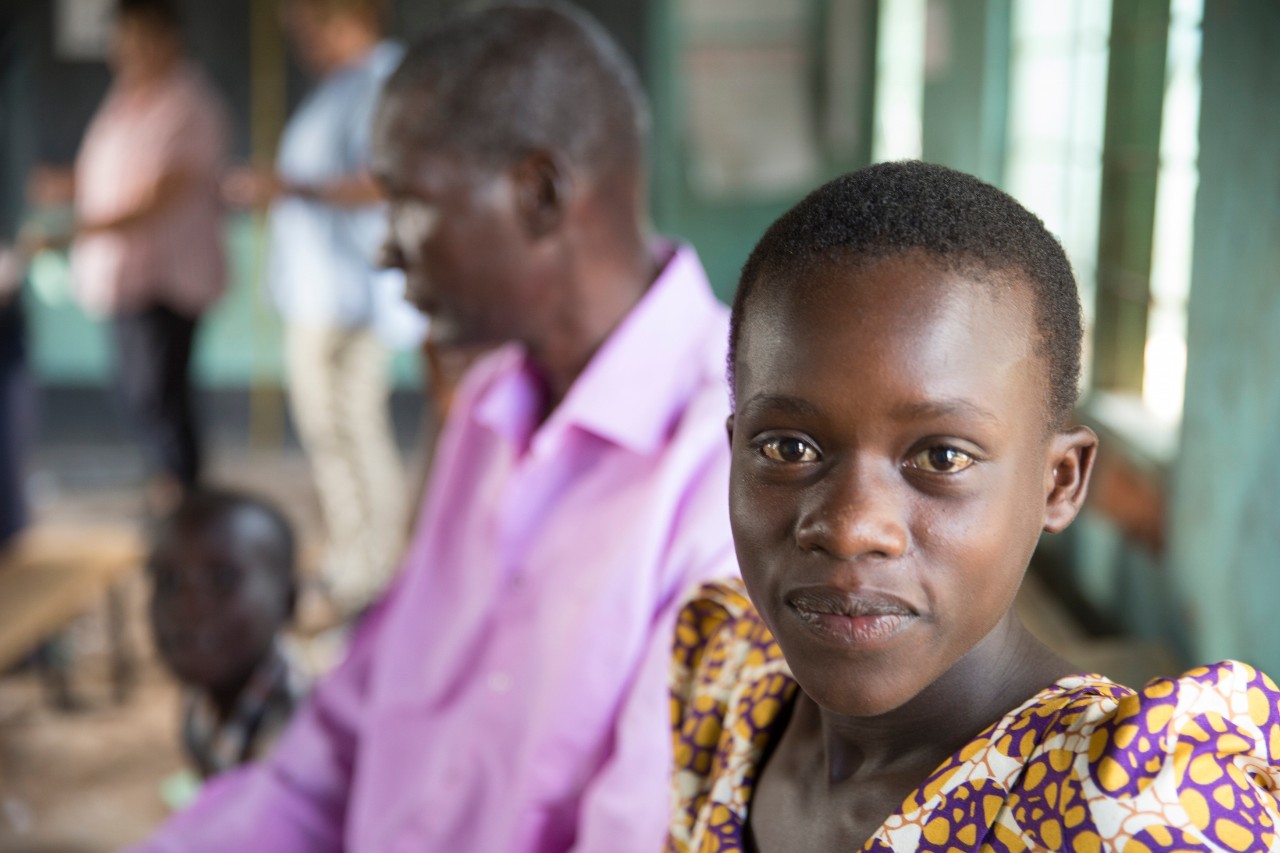
“Here you see disease states that have progressed vastly so much farther than they would before they would land in the health care system in the United States,” he says. “You see the end stage of different forms of pathology that literally these students only read about. Now they will actually see them.”
UC second-year medical student Katie Brown spent most of her trip shadowing Pancioli as they helped patient after patient. “I saw so many things I’d probably not see at home or at least not that severe,” she says. “There was a boy with ringworm on his head for two years. He had extensive hair loss and scalp bleaching. He had some of the worst scabies I’d ever seen as well as a belly full of worms.”
Brown says it is sad they can’t see everyone, but she’s encouraged that nearly everyone they did see had treatable illnesses. “I think kind of getting thrown into the fire has been a good experience,” she says. “It affirmed what I thought I knew.”
One thing she always knew was that she wanted to be a doctor since as early as she could remember. Her father, Anthony Brown, is a family physician in Cincinnati and would bring home disposable stethoscopes, and little Katie would wear them “all the time.”
“I would force my younger siblings to play doctor with me,” she laughs. “We would go into his office and play around in the exam rooms.”
You might say medicine is in her blood, considering her grandfather, Edward Brown, was also a doc. The elder Dr. Brown, A&S ’52, M(A&S) ’54, Med ’62, practiced medicine for 55 years in Cincinnati, mostly caring for underserved populations until pancreatic cancer forced him to retire. His death last November, Katie says, makes this opportunity to treat underserved people all the more poignant.
“I always grew up with a strong sense of justice and just absolutely hated seeing things that were unfair,” she says. “Seeing people who weren’t getting the same access to care and resources and how that can be determined by the ZIP code you are born in made a big impact.”
Once the UC team left, student Brown remained in Tanzania on her own another month to not only absorb the experience but to help local doctors meet the overwhelming medical needs.
The Brown family legacy, one might argue, remains in good hands.
r. Chris Lewis is riding shotgun in a 10-passenger van designed for African safaris. The convoy of eight vehicles just left Burere, a remote village in Tanzania that overlooks Lake Victoria in East Africa. Each van bounces mercilessly along the crude dirt roads as they return to Shirati village, home to the team’s in-country NGO, a 5-acre compound where the group of 34 on the June brigade sleep under mosquito nets each night.
Lewis, vice provost at the University of Cincinnati, is only minutes into the hour-long trip when his head sways left and right as the van rocks him from crater to pothole. His eyes close slowly as his head nods forward until his chin rests on his chest, where it stays for most of the drive back. Few seem able to sleep in such extreme conditions, but he may have mastered the art — whether from years of practice or perhaps just sheer exhaustion.
It’s the final day working in the villages, and the health team just wrapped up its second trip to the Burere primary school, where UC and UC Health professionals and students from the fields of medicine, nursing, pharmacy and allied health staffed a mobile field clinic inside the dirt-floor classroom buildings. They saw another 131 patients today, bringing the count for the trip to nearly 400, most of whom walked miles from their mud huts, often with sick children, many of them suffering with malaria, schistosomiasis (parasitic flatworms) or both. They returned with free medications.
Before seeing patients in Burere, Lewis started the morning 25 dusty miles away in the breezeway at the Roche Health Center by tackling some politics in a crucial two-hour meeting with a couple dozen village leaders. By way of a translator, they ask hard questions about expanding access to clean water, more food for kids in school and when family planning care might be expanded at the center. The back and forth signals the depth of an equal partnership. The men and women, gathered in a circle and sitting on plastic chairs, speak passionately about each topic, only to be distracted a moment when a rooster and hen fly into the circle. The locals stay focused and shoo them out calmly. But the barnyard interruption during an important meeting is clearly a reminder to the Americans in attendance that they truly are far from home in every sense imaginable.
Lewis responds methodically to each villager’s request and speaks equally as passionately about the need for the people of Roche to continue owning these issues and partnering on solutions like they have for the entire 15-year relationship. He encourages the leaders to promote the 24-hour services at the health center to their neighbors and thanks each of them for their dedication to committees for the Village Life Outreach Project, the nonprofit he founded 15 years ago.
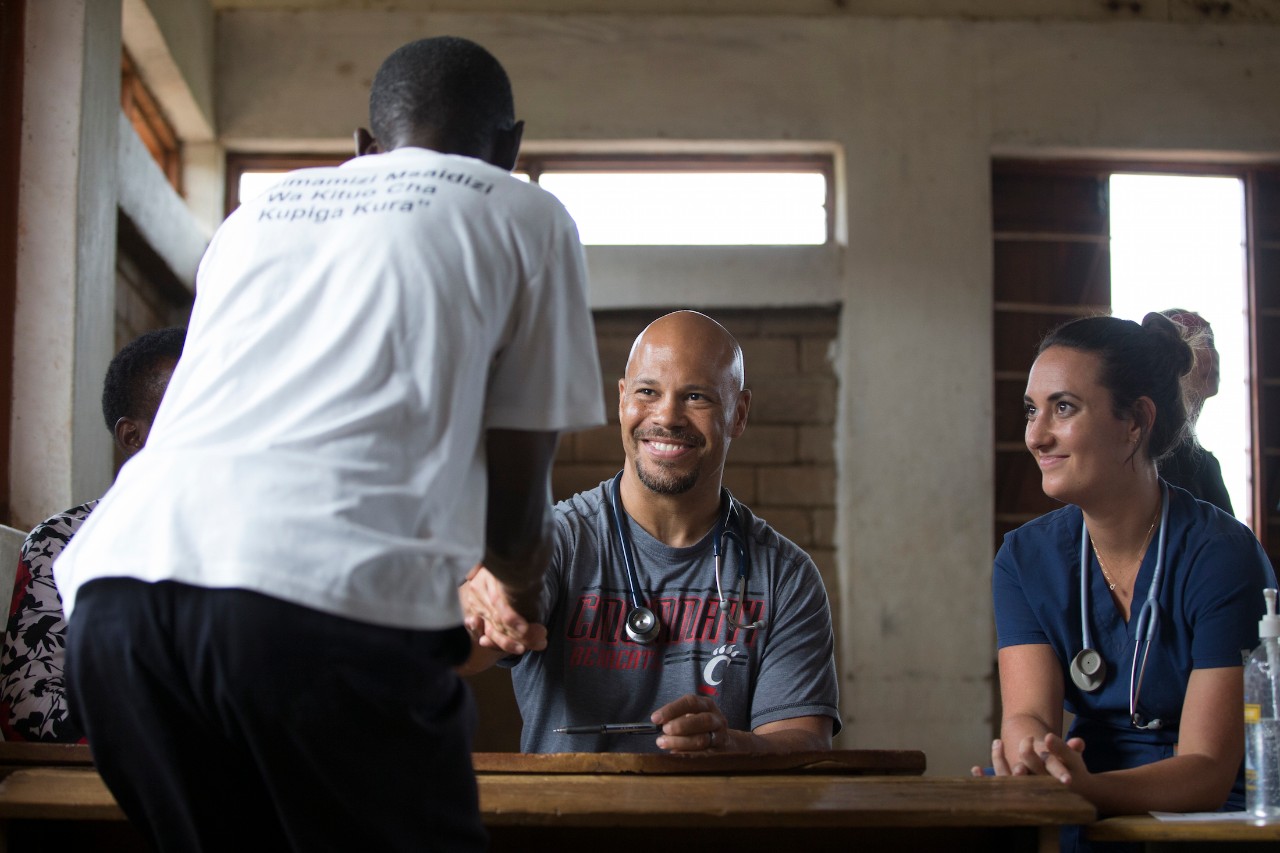
Reflecting on 15 years
Much has occurred and many lives have been altered since Village Life began in 2004, but at least two things haven’t changed for Lewis: his trip tunes and his backpack. He’s carried the same old-school iPod and the same baby blue daypack on 26 similar trips over the years. Call him sentimental, but “Dr. Chris,” which the locals say in a thick Swahili accent (and normally before a big embrace) clearly has a heart not just for where he’s been but also where he came from.
Growing up the son of hard-working parents in Finneytown, Ohio, his dad patched potholes and cleared snow for the Hamilton County engineer’s office, and his mother, who died last September, worked in facilities at UC. His parents raised him to “give of yourself to others,” he says. In fact, Martin Luther King Jr.’s famous quote was ingrained in him when he was a young man, and he now uses it to explain the “why” behind Village Life: “Life’s most persistent and urgent question is, ‘What are you doing for others?’”
“That was drilled into my head at an early age,” says Lewis, now 44, “but I never thought it would take me to Tanzania.”
He credits his interactions at Finneytown High School for watering the seeds his parents planted. He was surrounded by teachers, coaches and other students who had the same type of interest in service. Lewis left Finneytown in 1992 for Harvard University, where he completed his undergrad in biology before returning to UC to take advantage of his mom’s most valuable employment benefit. Tuition remission allowed him to attend medical school at no cost.
“I owe a lot of gratitude to this institution,” he laughs. “I graduated by the skin of my teeth.”
He stayed at UC in the early 2000s to complete his residency in family medicine and took part in a global health training program, where he learned about partnering with developing communities. Lewis had led some teams on trips to Honduras and El Salvador when an opportunity opened up to go to Africa in May 2003 during his final year of residency. Specifically, he would get the chance to spend a month at Shirati Hospital, one of only two hospitals in this part of East Africa serving half a million people.
“I came here thinking I’m talented and Western-trained, and I’m going to change the world.” A former high school wrestler and state qualifier, Lewis was used to staring into the eyes of scrappy challengers then pinning them to the mat. That wouldn’t be the case in Tanzania, however, where there’s plenty of grappling, but the victories come far slower. At Shirati Hospital, where he found himself as a student, medicines and clean water would sometimes run out, and it was common to lose power in the middle of a surgery.
“People are pulling out flashlights to finish an operation,” he recalls. His very first patient, a pregnant woman who walked more than 20 miles from an outlying village to deliver her baby, went into labor and began hemorrhaging on the way. She died before she could get to the hospital.
“So I have all these notions that I’m going to do all this great work, and my first patient is dead on arrival,” he says. “That experience completely flipped upside down my world view, what my purpose was and what I was going to do with all this training.”
Lewis graduated from residency in June 2003 and started building his own family practice, but the desire to go back to Tanzania “just kept eating away” at him. By October of 2004 he returned with 14 others, 10 of whom were from UC. With that, Village Life was born. He decided their efforts would be focused on serving the three outlying villages — Burere, Nyambogo and Roche — all of which are roughly an hour’s drive, and a much longer walk, to Shirati Hospital. To this day, Village Life works with a Tanzanian partner organization called the Shirati Health Education and Development Foundation, or SHED, which serves as the in-country host during trips and oversees all the projects on the ground year-round.
Life, health and education
Lewis quickly learned the key to success in Tanzania was listening first. What they heard in the dialogue was that most of the problems in the villages revolved around access to clean water and education for children. The women and children were carrying buckets of parasite-tainted water from Lake Victoria (or other bodies of water) back to their families on their head each morning. The schools were either falling down, or the children weren’t attending. In other words, the key issues were much deeper than a health crisis, and it would take a united approach working with the local communities to develop solutions.
“Ours was a mission of empowerment,” says Lewis. “A lot of people might come here and start thinking, ‘What resources can we provide?’ or ‘What can we do to solve this?’ With Village Life it was not about coming in with hand outs, but instead coming into these communities of intelligent, dedicated people and having dialogue with your hands in your pockets. The only thing you can do with your hands in your pockets is just listen and communicate with people.”
In the early years, UC experts and students from the College of Engineering and Applied Science developed a simple slow-sand filter using a bucket to clean the water. In each of the three villages, the locals started a water committee and reproduced the filtration devices by the hundreds. UC’s chapter of Engineers Without Borders (EWB) then carried the clean-water mission much further starting in 2009 after partnering with Village Life. In the last decade, UC’s EWB has built sustainable wells, water tanks, latrines, handwashing stations and water distribution systems in the three villages.
In 2011, Village Life was able to open and staff the Roche Health Center, a facility with 24/7 care that now provides more than 20,000 villagers their first access to permanent health care. The cost for care is a flat fee of 3,000 Tanzanian shillings for children and 5,000 shillings for adults, which equates to about $1.36 and $2.27 American, a price that’s still difficult for many in the region.
The facility, which now includes clean water and modern housing for the staff, was designed by former UC College of Design, Architecture, Art, and Planning professor Michael Zaretsky, who has remained heavily involved with Village LIfe, though he left UC in 2018. Zaretsky credits the work of his former UC grad student Emily Roush-Elliott, M (DAAP) ’11, who lived in Tanzania for several months in 2011 to help the villagers with construction. Construction workers will soon be busy again, it seems, thanks to a new $1 million endowment through the Anna and Harold W. Huffman Foundation this summer that will allow for a new maternal child health center at Roche. In 2014, UC Health made a 5-year $1,050,000 gift to expand efforts at Roche.
“Over the years, we’ve had hundreds of people invest in our work, and hundreds from Cincinnati travel to Tanzania to work here and contribute to what we’re doing,” says Lewis. “A gift of this size and a gift of this magnitude changes the trajectory of Village Life.”
A couple years after the Roche Health Center opened, Village Life and EWB also built a new primary school building that opened in Burere in 2013. The school now serves 600 students and has seven teachers, including James Okech, who has taught language, math and science in Burere for nearly a decade. Okech says he has seen an enormous positive change in the schoolchildren thanks to Village Life, especially the Uji Nutrition Project, which started in 2008 and expanded in 2017. Developed with the help of students at UC’s College of Allied Health Science (CAHS), the Uji Projects feeds about 2,500 students from all three villages a cup of uji (or porridge) every school day. Students who used to have to walk miles back to their homes to eat lunch can now stay at school through the day. The result is higher scores and healthier kids, says Okech, who often runs through the village to check on any students who are sick or absent.
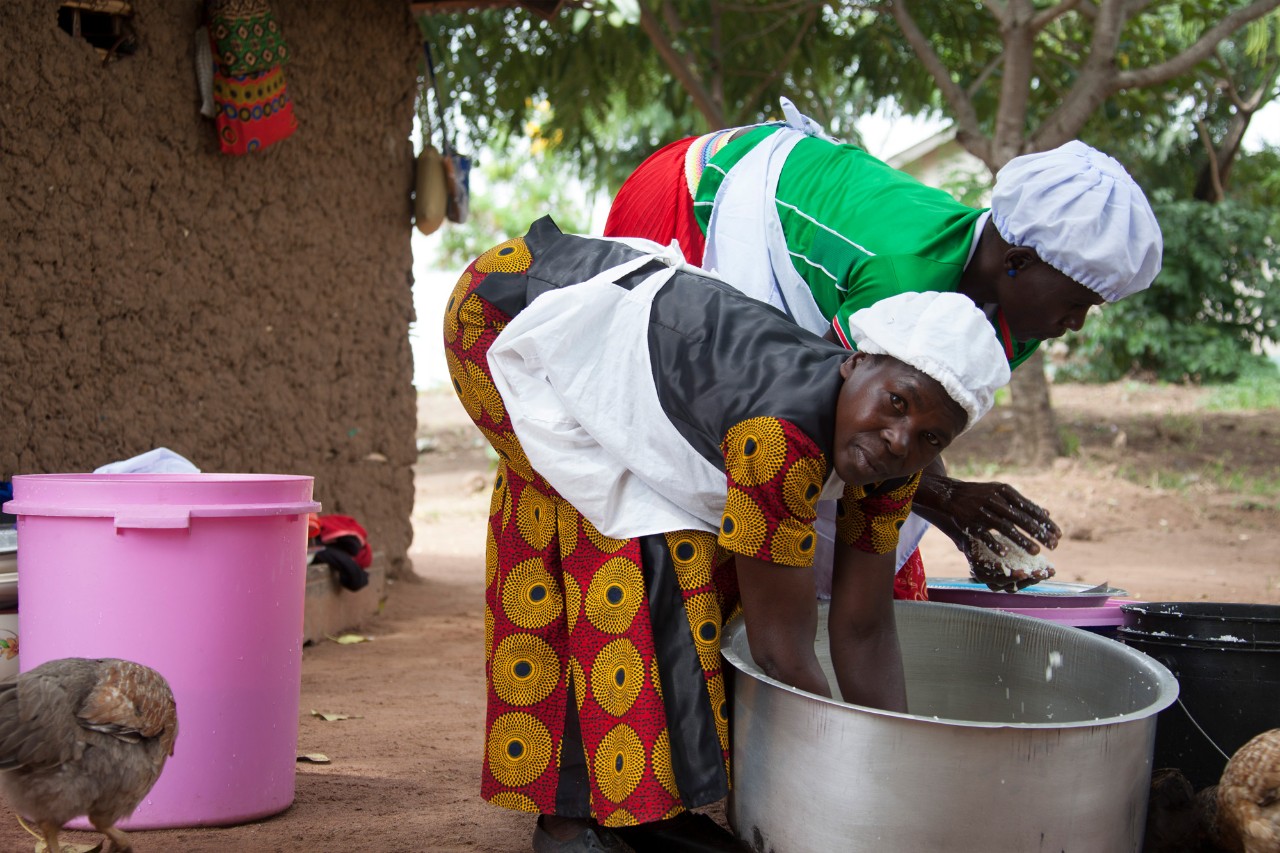
The Uji Nutrition Project is what attracted UC CAHS clinical dietician John Pantel on the June trip. He has experience working with students to help underserved populations in urban environments, and his new goal will be to send UC students with expertise in nutrition to Tanzania to collaborate on further developing uji (currently made of corn, sugar and water) to be more nutritious as well as sustainable. It currently costs about 4 cents per child per day, which adds up to about $100 a day.
Pantel’s eyes were opened wide while volunteering with the medical team intake area. He was recording height and weight for patients when he decided to determine the Body Mass Index (BMI) for some of the children. That’s when he realized he was seeing BMIs as low as 15, a startling number considering 18.5 is considered underweight.
“That’s really low,” he says. “Kids in the states would be hospitalized, and somebody would be calling social services. But I guess if you are only eating one cup of uji a day, it makes sense.”
CAHS also sent faculty member Xan Boone on the trip to explore additional partnership possibilities between Village Life and the college’s programs in social work, physical therapy, speech audiology and more. She left encouraged at the potential. “This is miracle stuff,” says Boone. “Seeing this and what Village Life and all these volunteers are doing, my heart just grows. The gifts you get are so much greater than the gifts you give.”
Lewis agrees and adds that it’s the people of Tanzania that motivate him to continue the work of Village Life.
“Their ability to overcome obstacles from birth really gives them this passion and this commitment that is beautiful to witness in person, and it’s one of the reasons why I keep going back,” he says. “Despite the overwhelming poverty, the folks that we work with in Tanzania are some of the wealthiest people in the world.”
niversity of Cincinnati students from Engineers Without Borders have spent the last decade helping three water-stressed villages in Tanzania tap into clean water.
Preskila Alex gives Mark Miller a giant hug every time he visits Nyambogo.
A member of the water committee there, she and Miller share one of the sweetest memories in the village’s storied history — the day they hit water in August 2014 and clean, delicious drinkable water shot into the sky and rained down on them.
Miller, a 1982 engineering alumnus from UC, is the professional mentor for the University of Cincinnati Engineers Without Borders (EWB) and recalls the trip five years ago. Up until then, the village of several thousand, like many others around it, had no access to potable water. And drinking from nearby sources was only spreading schistosomiasis, a disease caused by parasitic flatworms called schistosomes. Symptoms include abdominal pain, diarrhea, bloody stool or blood in the urine.
The EWB team had been on the ground in Tanzania nearly a full week and were down to their last day of drilling a well for water. After a series of delays, including a broken drill bit, Miller remembers everyone exchanging nervous glances as the drill bit passed 95 meters, about where they estimated there to be water.
Then it happened.
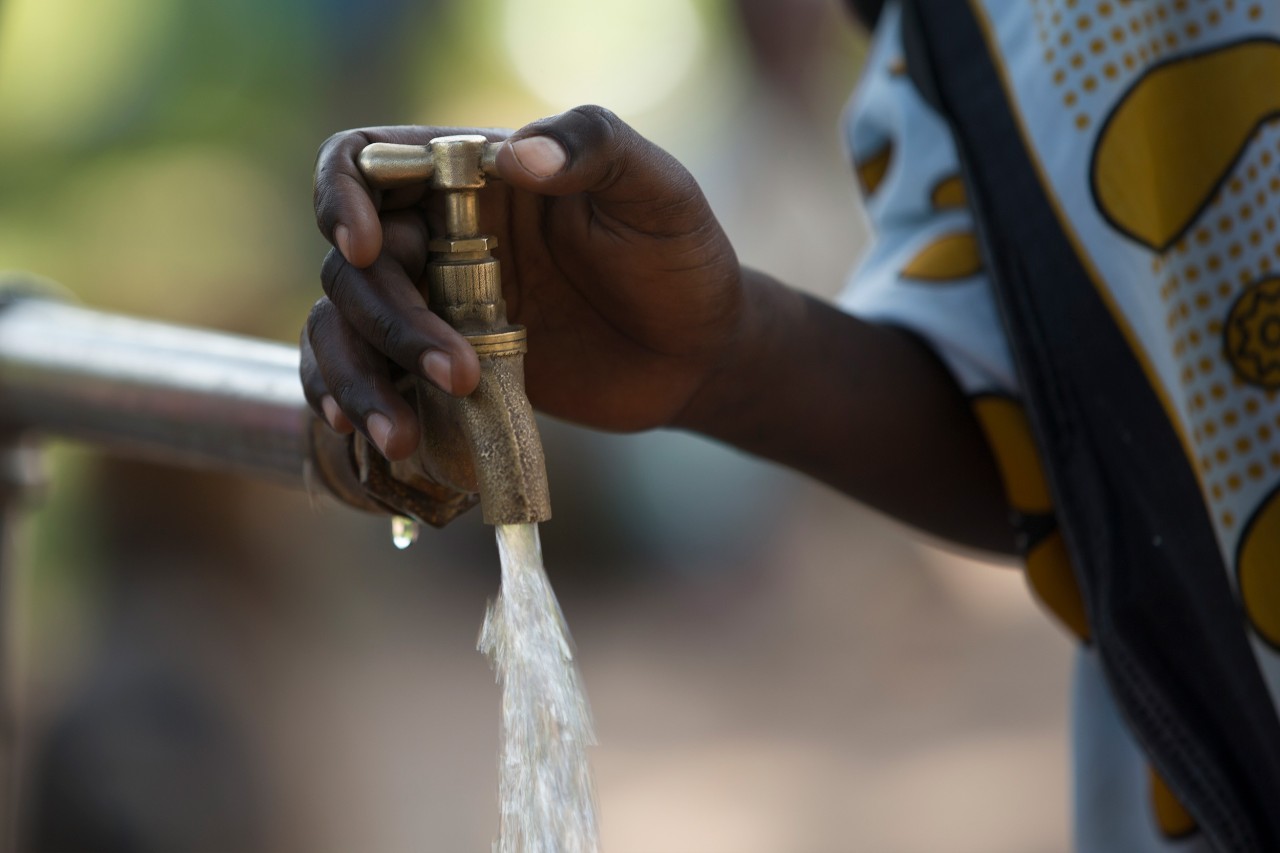
“You’ve got a 3,000-horsepower air compressor drilling, as you’re driving the bit and blowing the air out of the hole,” he says. “And then it changes color, and then it turns to water. The people just went crazy. Everybody was running home and getting buckets and washtubs. I remember Preskila just standing there while a fire hose worth of water rained down on everybody.”
Fast forward to 2019, and Nyambogo is now the poster child not just for successfully drilling for water but, with EWB’s help, villagers installed a sustainable distribution system in 2016 that allows them to pump water to nearby villages as well as to two nearby schools. The Nyambogo Water Committee has even expanded water lines to several households and has been able to replace equipment using revenue obtained from selling water at the taps. To date, they’ve distributed more than 2.7 million gallons of clean water.
Over the years EWB has partnered with Village Life Outreach Project, and Miller, a mechanical engineer for Jacobs Engineering with almost 40 years of experience, even sits on the nonprofit’s board. Each busy trip to Tanzania normally involves several UC students from the College of Engineering and Applied Science, and over the last decade, UC’s EWB has built wells, water tanks, latrines, handwashing stations and more in Nyambogo, Burere and Roche villages.
UC ON SAFARI
Those who venture 8,000 miles from Cincinnati to Tanzania to volunteer with Village Life Outreach Project also get to experience a two-day safari in the Maasai Mara National Reserve as part of the return trip through Kenya. The park is named after the Maasai tribe, a semi-nomadic tribe best known for their vibrant red garments and herds of cattle.
Organizers consider the experience to be a once-in-a-lifetime treat and an amazing personal reward for the incredible amount of effort each person on the brigade puts into serving others while in Africa.
“You cannot go all the way over there and not connect with mother Earth,” says Village Life Founder Chris Lewis. “You have to go on a safari.”
The safari experience includes breathtaking game drives led by drivers from Just Connections, Village Life’s transportation partner, who take the members from the brigade throughout the park, which is an expanse of 600 square miles. The safari vehicles come within feet of countless wild animals, including “the Big Five”: lion, leopard, rhinoceros, elephant and the African buffalo.
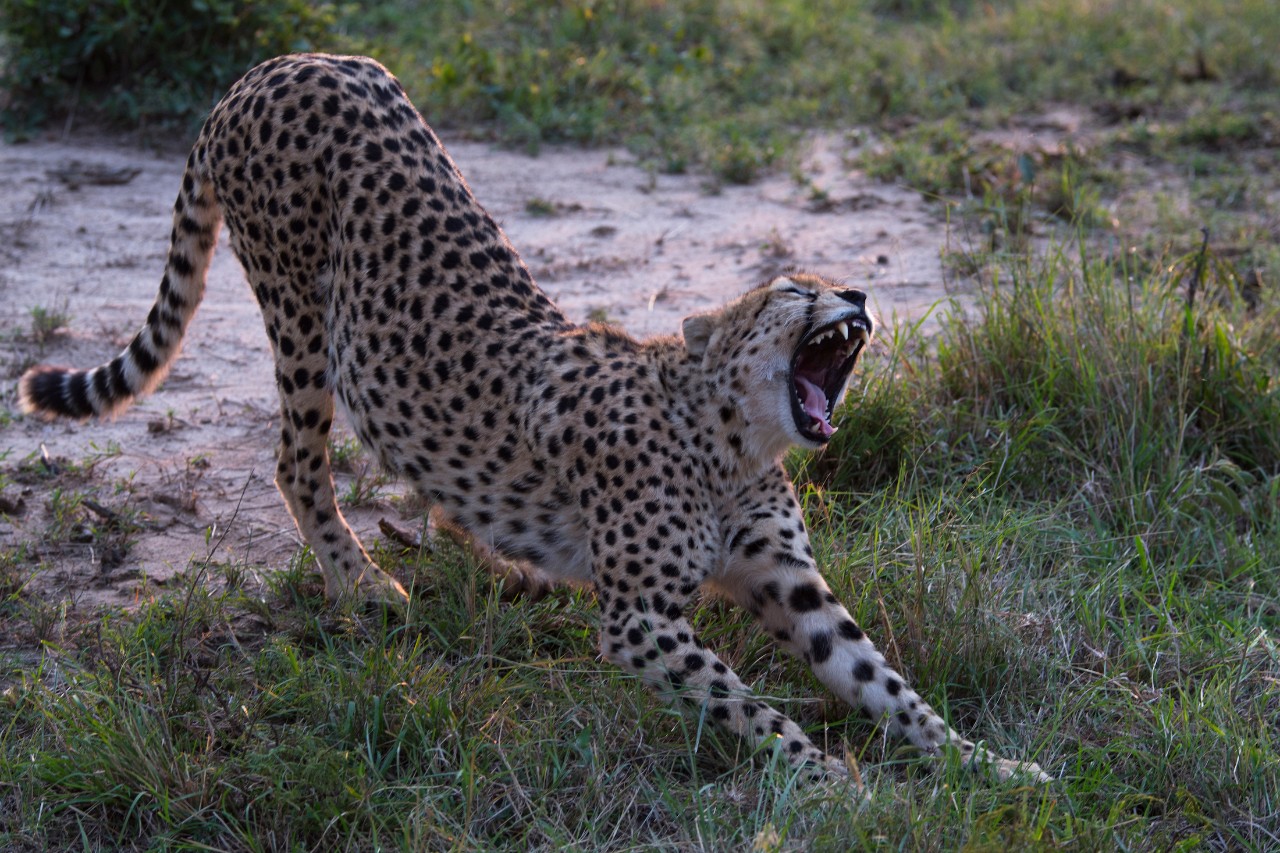


Katie Brown
A second-year medical student, she shadowed the doctors during clinic at both Burere and Nyambogo villages. She also was the one student on the trip who stayed back in Tanzania a full month after everyone else left, to help with medical care.
“There was a baby with malaria, and his test came up positive almost immediately though it normally takes 20 minutes. He must have had a very high parasitic load. He was clearly in respiratory distress. He had nasal flaring. He was breathing really fast, and he was using all of his chest muscles to help him breathe. His lungs just sounded like a pool and gurgling really, really bad. So that was shocking to see a baby that sick.”


Diandra Fortune
A first-year medical student, she shadowed the docs in the village clinics and was able to observe and assist with care at the Roche Health Center, which the Village Life Outreach Project constructed in 2011.
“I’ve learned a lot about these diseases in medical school, but I’ve never seen it quite like this. You see pictures but the translation and the extent to which that disease can go is totally different. We saw someone with end-stage liver failure from schistosomiasis (flatworms) and that was something I’ve never seen before. I’ve never seen someone that anemic, so it was kind of like seeing the extreme of what your textbooks said. It was pretty wild, but at the same time super humbling.”


Ashley Mosher
A first-year mechanical engineering student, she represented UC’s chapter of Engineers Without Borders, a partner organization with Village Life, by working on water projects with EWB mentor and UC alumnus Mark Miller, CEAS ’82, at Burere, Nyambogo and Roche.
“Sometimes in engineering you work on one drawing for a long time, and you never see how it impacts people, but what makes this trip so amazing is that I’ll actually get to see the impact of my work. I definitely want a position where my work isn’t just making my life easier, but making other’s lives easier.”


Alex Wahl
A first-year mechanical engineering student, he represented UC’s chapter of Engineers Without Borders by working on water projects with EWB mentor and UC alumnus Mark Miller, CEAS ’82, at Burere, Nyambogo and Roche.
“Even though they have very little, I’ve never met happier people. The children scream ‘hello’ and wave and smile, and the adults shake your hand. They are really happy to meet us. I’ve worked with charities in America, and the people that receive help just don’t seem as happy. They definitely have a joy here that you don’t see in everyday America."


John Paul Pancioli
A third-year Lindner College of Business undergraduate studying operations management, he joined his sister, Maria Pancioli, his father, Dr. Art Pancioli, and his stepmom, Dr. Lisa Larkin on the trip, where he split time between helping on the water projects with the engineering team and working intake at the medical clinics.
“We worked on the process flow for the clinic. We took it on like an operations project and recorded time series data for the different patients, figured out where the bottlenecks were and tried to improve the intake flow in order to improve the entire flow. That day we covered 65 patients in 3.5 hours. I expected to come on this trip and just be a helping hand, but to really get to implement what I learned in school is pretty awesome.”


Maria Pancioli
An incoming first-year student in DAAP’s horticulture program, she joined her brother, John Paul Pancioli, her father, Dr. Art Pancioli, and her stepmom, Dr. Lisa Larkin, on the trip where she assisted with the clinic’s intake function and even got to shadow the doctors.
“I’m still really excited about horticulture, but I want to make sure I keep my options open, in case I decide later to switch to medicine. My view of medicine has actually changed quite a bit over the course of this trip. I hadn’t witnessed the beauty of medicine until I came here.”


Lauren Stacey
A fourth-year pharmacy student, Lauren was the lone trained pharmacist on hand to help fill hundreds upon hundreds of prescriptions for patients in each village.
“With any kind of graduate school, you can lose sight of why you picked that profession in the everyday hustle bustle, whether it’s tests, work or whatever. In the first day of clinic, I immediately remembered why I chose pharmacy in the first place. It just kind of renewed my passion for pharmacy.”


Sabrina Bernardo
A third-year nursing student, she took vitals at the pop-up clinics as part of intake at both village schools in Burere and Nyambogo. She also observed the Roche Health Center clinic.
“It’s hard because in the States you can prevent a lot of these illnesses or a lot of them are curable. But here, they don’t have the same privileges or resources that we do. And it’s been kind of eye-opening, too, because it made me grateful for what I have.”
About the project
Funded by Marketing + Communications, writer John Bach, photographer Lisa Ventre, designer Angela Klocke and photo intern Ravenna Rutledge accompanied the Village Life Outreach Project brigade to Africa in June 2019 as an effort to capture the amazing international experiences and outstanding efforts to impact our world by the University of Cincinnati. Special thanks to VLOP’s Buthaina Karaman for her outstanding efforts to organize and plan all trip logistics as well as help make this coverage possible.
Additional Credits
Web development and digital design by Kerry Overstake and Ben Henson. Video by Lisa Ventre, Paul Grundy, Ben Gardner and Andrew Higley.
FEATURE STORIES
The nonprofit Village Life Outreach Project has sent hundreds of volunteers from UC to three remote villages in East Africa since it started 15 years ago, an effort that has deeply impacted countless lives on both sides of the world.
UC has invested $100,000 in Cincinnati nonprofits to commemorate the Bicentennial's impact in the community.
The new home of the University of Cincinnati’s business college is built to foster collaboration, adapt to future needs. Also featured is the brand new Allied Health Sciences building.
